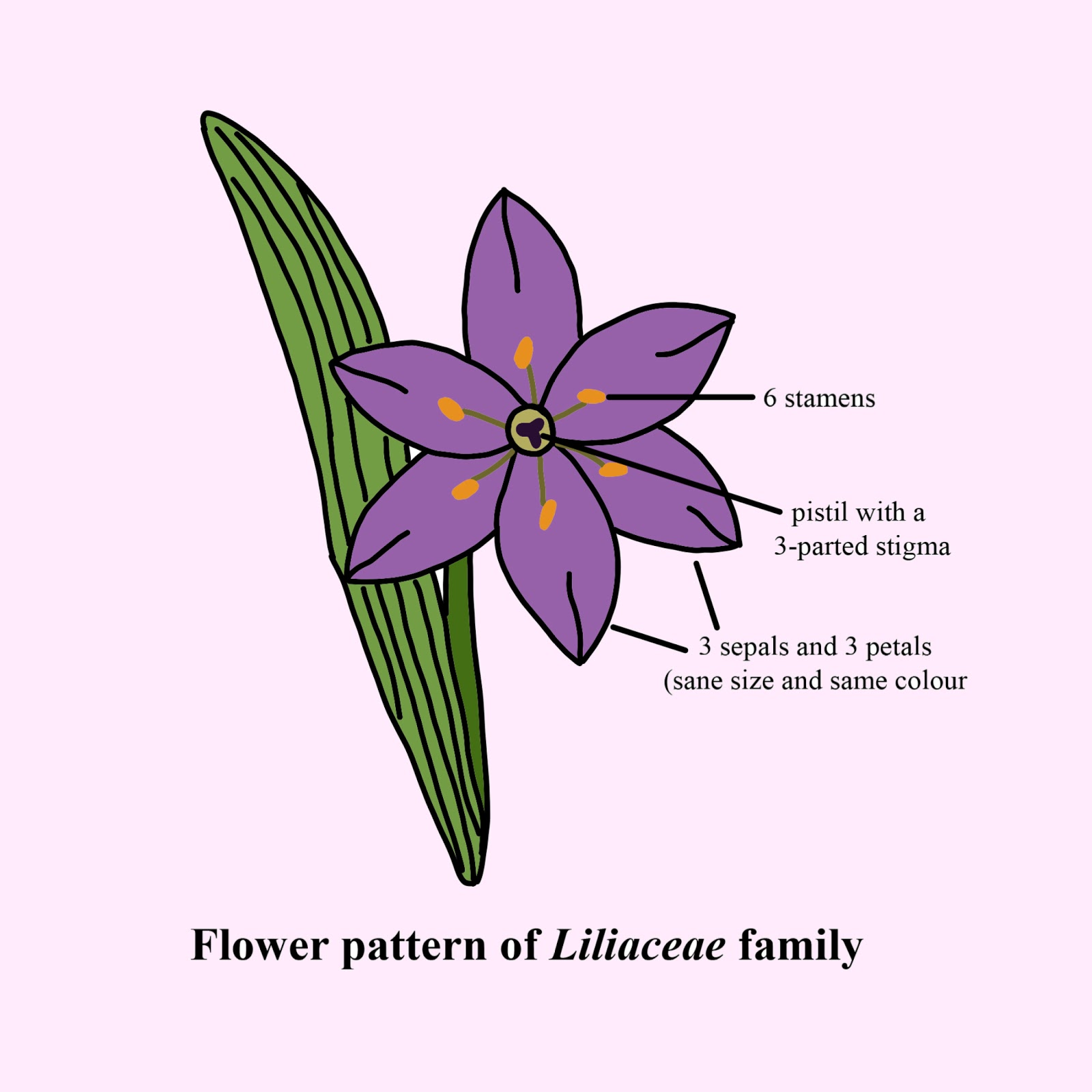
Family Liliaceae is characterized by
(a) Trimerous flower
(b) Tetramerous flower
(c) Pentamerous flower
(d) Zygomorphic flower
Answer
493.8k+ views
Hint: Liliaceae are herbaceous monocots rarely shrubs. In the Liliaceae family, all the parts of the flower are 3 in number. Flowers have superior ovaries in the family Liliaceae, i.e. the gynoecium holds its highest position. A wide variety of plants belong to the family Liliaceae.
Complete answer:
Characteristics of family Liliaceae:
-Vegetative Characters:
Root: This family has a fibrous adventitious root system, but sometimes tuberous as well as seen in Asparagus.
Stem: Stem is generally erect, either herbaceous or woody, solid, or fistular. The underground stem might be present which is known as corm, bulb, or rhizome as observed in some species.
Leaves: The shape of the leaf is variable, mostly basal having alternate phyllotaxy, exstipulate with parallel venation.
-Floral Characters:
Inflorescence: The inflorescence is generally variable ranging from solitary to cymose. It is often present as umbellate clusters.
Flower: They have bisexual flowers that are usually trimerous rarely di or tetramerous, having radial symmetry (actinomorphic).
Perianth: Six (3+3 arrangement) which is often united into a tube having valvate aestivation.
Androecium: Six (3+3 arrangement) polyandrous, epiphyllous, antiphyllous, filaments long, anthers versatile.
Gynoecium: The gynoecium is generally tricarpellary, syncarpous, ovary superior or half inferior, trilocular, or unilocular with two ovules, axile placentation, style simple; stigma trilobed or 3-parted.
Fruit: Usually capsule, rarely a berry.
Seed: Seeds are endospermic.
Floral formula: Br ${P}_{3+3} {A}_{3+3} {G}_{(3)}$.

So, the correct answer is ‘Trimerous flower’.
Note:
The plants belonging to the Liliaceae family are of economic importance. Some of them are listed as:
- Aloe vera, Smilax, and Colchicine are some common medicinal plants.
- Lilium, tulips, Gloriosa, and Ruscus have ornamental values.
- Asparagus is a source of food.
- They can be used as flavoring agents such as Bulbs of Allium cepa and the roots of various species of Smilax.
Complete answer:
Characteristics of family Liliaceae:
-Vegetative Characters:
Root: This family has a fibrous adventitious root system, but sometimes tuberous as well as seen in Asparagus.
Stem: Stem is generally erect, either herbaceous or woody, solid, or fistular. The underground stem might be present which is known as corm, bulb, or rhizome as observed in some species.
Leaves: The shape of the leaf is variable, mostly basal having alternate phyllotaxy, exstipulate with parallel venation.
-Floral Characters:
Inflorescence: The inflorescence is generally variable ranging from solitary to cymose. It is often present as umbellate clusters.
Flower: They have bisexual flowers that are usually trimerous rarely di or tetramerous, having radial symmetry (actinomorphic).
Perianth: Six (3+3 arrangement) which is often united into a tube having valvate aestivation.
Androecium: Six (3+3 arrangement) polyandrous, epiphyllous, antiphyllous, filaments long, anthers versatile.
Gynoecium: The gynoecium is generally tricarpellary, syncarpous, ovary superior or half inferior, trilocular, or unilocular with two ovules, axile placentation, style simple; stigma trilobed or 3-parted.
Fruit: Usually capsule, rarely a berry.
Seed: Seeds are endospermic.
Floral formula: Br ${P}_{3+3} {A}_{3+3} {G}_{(3)}$.

So, the correct answer is ‘Trimerous flower’.
Note:
The plants belonging to the Liliaceae family are of economic importance. Some of them are listed as:
- Aloe vera, Smilax, and Colchicine are some common medicinal plants.
- Lilium, tulips, Gloriosa, and Ruscus have ornamental values.
- Asparagus is a source of food.
- They can be used as flavoring agents such as Bulbs of Allium cepa and the roots of various species of Smilax.
Recently Updated Pages
Master Class 12 Business Studies: Engaging Questions & Answers for Success

Master Class 12 Economics: Engaging Questions & Answers for Success

Master Class 12 English: Engaging Questions & Answers for Success

Master Class 12 Maths: Engaging Questions & Answers for Success

Master Class 12 Social Science: Engaging Questions & Answers for Success

Master Class 12 Chemistry: Engaging Questions & Answers for Success

Trending doubts
What is meant by exothermic and endothermic reactions class 11 chemistry CBSE

Which animal has three hearts class 11 biology CBSE

10 examples of friction in our daily life

One Metric ton is equal to kg A 10000 B 1000 C 100 class 11 physics CBSE

1 Quintal is equal to a 110 kg b 10 kg c 100kg d 1000 class 11 physics CBSE

Difference Between Prokaryotic Cells and Eukaryotic Cells




